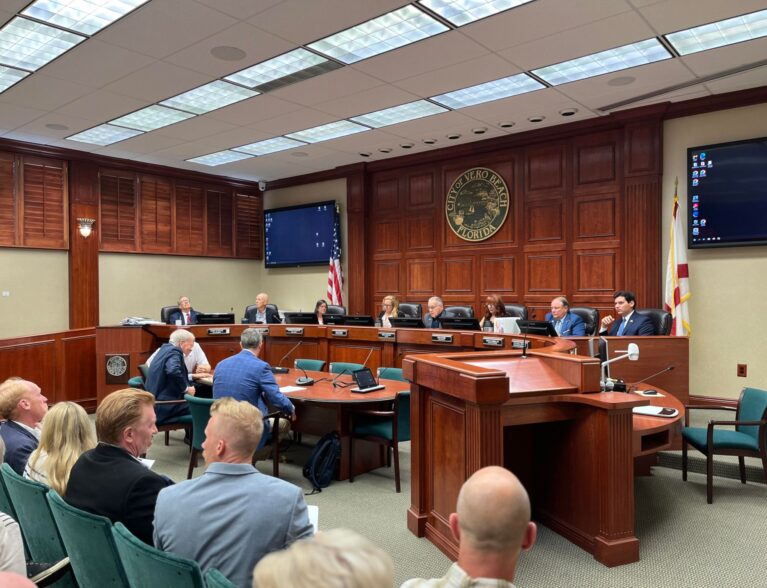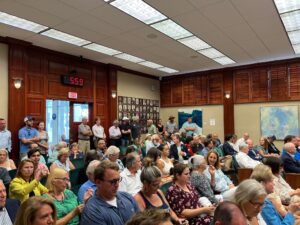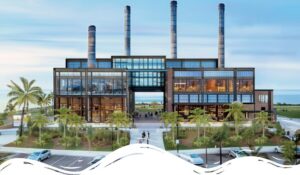
VERO BEACH — The room was quiet, and the audience on the edge of their seats as City Manager Monte Falls announced the top developer set to transform an old power plant location into a modern community hub. Before the cheers and hoorays, the council – which ranked their suggestions – heard from 26 residents late Tuesday on which development group had the best vision for the city.
Two out of four teams stood out from the rest – SūDā CREC Madison Group and Clearpath Services. It seemed like a tug-of-war match between supporters of the groups. In the end, residents and a majority of the council veered toward a more cost-sustainable proposal that would welcome people of all socioeconomic backgrounds, not price out mainland residents and protect the Indian River Lagoon.

Residents attend a Vero Beach City Council meeting on May 28, 2024, to hear which development group will lead the Three Corners project. PHOTO BY NICK SAMUEL
“Clearpath’s design was spectacular, but the cost was frightening,” said Peter Polk, the project manager for Three Corners, during the city council meeting. “SūDā had the right combination and the right design. SūDā (representatives) talked about the connection to the environment and community. People liked that.”
The four proposals were submitted by Clearpath Services; SūDā , CREC Capital and Madison Marquette partnership; Vista Blue Vero Beach Resort & Spa and Edgewater Group. On May 17th, the Three Corners Selection Committee recommended Clearpath to redevelop the old power plant, located on the west end of the Alma Lee Loy (17th Street) Bridge near Indian River Boulevard.
Ultimately, SūDā CREC Madison Group ranked as the top developer to repurpose the 38-acre parcel into something future generations can enjoy. Clearpath was the runner-up.
It was a decision not to be taken lightly and comes with a 99-year-lease.
“It was close…two different but compelling visions,” said David Brainerd, chief investment officer at Madison Marquette.
Clearpath’s $504 million proposal had included a boutique hotel with a contemporary art museum, great hall with food offerings and office space, on-the-water event center, restaurants, 43-slip marina, kayak canal, community parks with an amphitheater, splash park, skate park, waterfront village and more than 700 parking spaces.
SūDā’s $189 million proposal includes an arching portal that will create a visual and pedestrian connection to the waterfront. The north side of the old power plant – nicknamed “Big Blue” – will include a lifestyle boutique hotel, state-of-the-art meeting facilities, and an elevated amenity deck with river and ocean views. The south side of the property will feature multifunctional venues for live music, cultural and arts events, festivals, marketplace, rooftop lounge with views of the public parks below and the marina.
SūDā’s plan will also have a public market and gourmet food bazaar retail space, landscaped tropical gardens and open spaces for public gatherings. The project highlights sustainability, focusing on eco-friendly building materials, energy efficient designs and green spaces to minimalize the environmental impact, according to its website.
“I thank the community, city council and staff for finding us worthy and giving us this enormous responsibility to build something iconic and enduring for future generations,” said Gaurav Butani, founding principal of SūDā . “We will create something that has meaning and depth. Future generations will value and treasure it.”
Deciding on Vero’s future
What will Vero Beach – recognized nationally as one of America’s best beach towns – look like years from now? What will the old power plant, which many consider an eyesore, look like?
The former electric plant site is considered the most valuable city publicly owned waterfront property on Florida’s east coast, according to city officials. For residents and most city councilmembers, keeping the city charm of Vero Beach was crucial in deciding which developer would reshape the historical site.
Brad Weiser, managing partner at CREC Capital, said SūDā CREC Madison Group focused on what they believed the people of Vero Beach wanted.

Three Corners rendering provided by SūDā CREC Madison Group
“People make decisions on what they think is best for the community,” Weiser said. “We’re excited. The proof is in the pudding. Now, work lies ahead.”
With Tuesday’s decision, community leaders must now hold the city to the highest standards of excellence, said Lance Lunceford, chairman and president of the Taxpayers Association of Indian River County.
“Nothing is more important to the future of the city than ensuring the successful redevelopment of the Three Corners. The City Council chose SūDā, but regardless of the selected developer the most important considerations in this project lie ahead,” Lunceford said. “The success of this project will chart the next hundred years of our ‘something special city.'”
The brainstorming on how to redevelop the abandoned industrial site began back in 2019 with the formation of the Three Corners Steering Committee, which guided the planning process.
Last August, the city issued requests for proposals from prospective developers. The four firms submitted their proposals on Feb. 1. The Three Corners Selection Committee gave a strong recommendation for Clearpath to the city council on May 17 based on interviews and financial assessments.
Construction for Three Corners was expected to happen sometime in 2030, city officials said.



